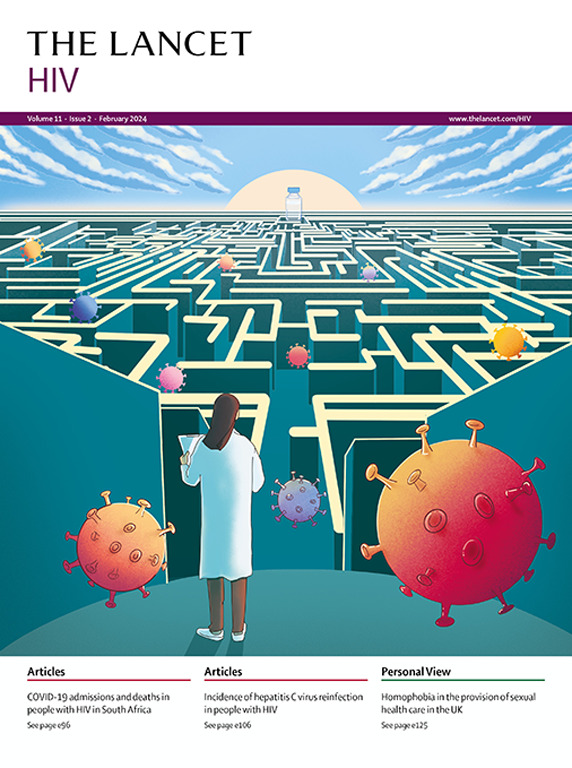Predictors of treatment-emergent resistance to dolutegravir
IF 13
1区 医学
Q1 IMMUNOLOGY
引用次数: 0
Abstract
Integrase strand transfer inhibitor (INSTI)-based regimens became a first-line treatment for HIV worldwide in 2018, with 93% of people with HIV who are on antiretroviral therapy (ART) estimated to be taking dolutegravir-based regimens as of 2023. Since the genetic barrier to resistance of dolutegravir is not impenetrable, rising rates of dolutegravir resistance among those with virological failure on this drug regimen have been reported. Risk factors for dolutegravir resistance include treatment experience, having background resistance to the nucleoside reverse transcriptase inhibitors in the regimen, switching to tenofovir, lamivudine, and dolutegravir when viraemic on a former regimen, previous experience with first-generation INSTIs, and being on dolutegravir monotherapy or dual therapy, with rates higher in children than in adults. HIV drug resistance does not emerge if selective drug pressure is not present, so some exposure to the ART regimen with virological failure is associated with higher rates of resistance than complete non-adherence. Detectable objective metrics of adherence (eg, ART drug concentrations in urine, plasma, dried blood spots, and hair) have been associated with high levels of viral resistance and can be used to triage who needs resistance testing the most.治疗后出现的多替韦耐药预测因素
2018年,基于整合酶链转移抑制剂(INSTI)的方案成为全球艾滋病毒的一线治疗方案,据估计,截至2023年,93%正在接受抗逆转录病毒治疗(ART)的艾滋病毒感染者正在服用以曲地韦为基础的方案。由于多替重力韦耐药的遗传屏障并非不可穿透,因此有报道称,在采用该药物方案的病毒学失败的患者中,多替重力韦耐药的比率正在上升。dolutegravir耐药的危险因素包括治疗经验,在治疗方案中对核苷逆转录酶抑制剂有背景耐药,在前一方案中出现病毒血症时改用替诺福韦、拉米夫定和dolutegravir,以前使用第一代胰岛素抑制剂的经验,以及正在使用dolutegravir单药或双重治疗,儿童的比例高于成人。如果不存在选择性药物压力,就不会出现艾滋病毒耐药性,因此,与完全不遵守抗逆转录病毒治疗方案相比,接受某些病毒学失败的抗逆转录病毒治疗方案的耐药率更高。可检测的依从性客观指标(例如,尿液、血浆、干血点和头发中的抗逆转录病毒药物浓度)与病毒耐药性高水平相关,可用于区分最需要进行耐药性检测的人群。
本文章由计算机程序翻译,如有差异,请以英文原文为准。
求助全文
约1分钟内获得全文
求助全文
来源期刊

Lancet Hiv
IMMUNOLOGYINFECTIOUS DISEASES&-INFECTIOUS DISEASES
CiteScore
19.90
自引率
4.30%
发文量
368
期刊介绍:
The Lancet HIV is an internationally trusted source of clinical, public health, and global health knowledge with an Impact Factor of 16.1. It is dedicated to publishing original research, evidence-based reviews, and insightful features that advocate for change in or illuminates HIV clinical practice. The journal aims to provide a holistic view of the pandemic, covering clinical, epidemiological, and operational disciplines. It publishes content on innovative treatments and the biological research behind them, novel methods of service delivery, and new approaches to confronting HIV/AIDS worldwide. The Lancet HIV publishes various types of content including articles, reviews, comments, correspondences, and viewpoints. It also publishes series that aim to shape and drive positive change in clinical practice and health policy in areas of need in HIV. The journal is indexed by several abstracting and indexing services, including Crossref, Embase, Essential Science Indicators, MEDLINE, PubMed, SCIE and Scopus.
 求助内容:
求助内容: 应助结果提醒方式:
应助结果提醒方式:


